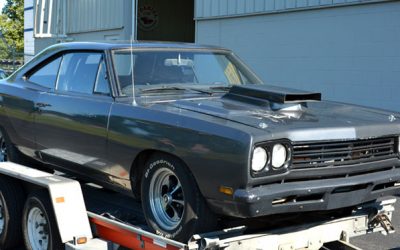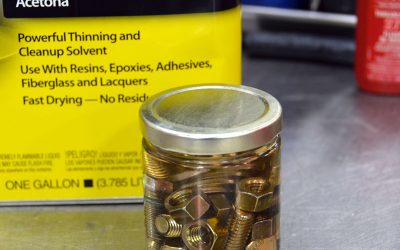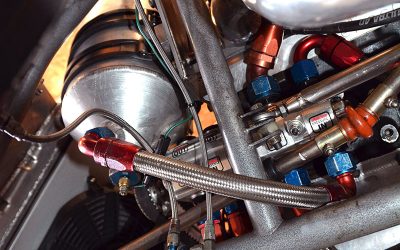To those of us who thrive on the sounds and smells of hot rodding, this just seems all wrong, but the performance is definitely there to a degree you might not even believe.
 At the 2013 Pike’s Peak Hill Climb, they had to put audible alarms on the electric-powered competitors to warn spectators that a vehicle was coming fast so that they’d stay off the roadway. The EVs didn’t win in the car class, but made a respectable showing with fifth place. An electric motorcycle finished first in the unlimited class, however, beating nasty 1,200cc I.C. bikes. The thing about electric motors is that the torque comes in instantly, no waiting for rpm to get into the power band.
At the 2013 Pike’s Peak Hill Climb, they had to put audible alarms on the electric-powered competitors to warn spectators that a vehicle was coming fast so that they’d stay off the roadway. The EVs didn’t win in the car class, but made a respectable showing with fifth place. An electric motorcycle finished first in the unlimited class, however, beating nasty 1,200cc I.C. bikes. The thing about electric motors is that the torque comes in instantly, no waiting for rpm to get into the power band.
The latest records I’ve found on the NEDRA (National Electric Drag Racing Association) site are also incredible. In the 355-volt class, how about 6.940 seconds at 201.37 mph? Or, the Miata “doorslammer†that’s done 9.122 at 145.16? Of course, the motors get so hot they have to pack them in dry ice between runs (isn’t that CO2 escaping?).
There’s also a go-kart in the Netherlands that was put together by a group of students. With a 33 hp electric motor at each wheel, it hits 100kph (62 mph) in a hair over two seconds, which is purported to be the world’s record for any vehicle.
This changes everything. When I was young, the main thing that differentiated a skill-challenged peon from an “A†mechanic was the ability to build or repair an internal-combustion engine. I took pride in learning that, and all the scientific subtleties of combustion, metallurgy, and fine measurement that went with it.
If that makes me sound negative about the rise of EV racing, it’s not just nostalgia, or the sinking feeling that I’m becoming obsolete. It’s also because I’ve had a long and disappointing relationship with electrics. As an automotive technology and service journalist during the energy crises of the 1970s, I did lots of research into alternative energy for individual transportation — Stirling engines, fuel cells, hydrogen fuel, turbines, hybrids, and, of course, electric vehicles. My first actual experience with an EV was monumentally unsatisfactory. It was the ElCar, the worst, least practical vehicle I’ve ever driven. Both accel and decel hammered me as cells were cut in and out to “control†the speed, the whining was barely tolerable, and the thing could just about get you to your mailbox and back on a charge. My old I-H Cub Cadet tractor was a turnpike cruiser by comparison, and its range was limited only by how much gasoline you felt like dumping into it. I’m always reminded of what a Volvo engineering paper stated back then: “There is not even a theoretical possibility†of any possible battery ever approaching the energy density of liquid hydrocarbons. So, you’ll be seeing electric dragsters, but don’t expect an EV to be competing at Indianapolis or Daytona for 500-mile races. Not unless they’ve got an onboard nuclear reactor.
Without trying to be political about it, I should mention the impetus behind this departure from traditional I.C. power in motorsports, and the embracing of what are perceived to be environmentally-sound means of propulsion, and where they might be going. A large percentage of the population is sold on “green,†and regardless of the fact that EVs are typically charged by electricity generated by burning coal, the appeal of electrics is strong. On the other hand, what the climate change believers refer to as a “pause†in global warming (since 1998!), and the inconvenient truth that a research ship was stuck in an unusual thickness of ice near Antarctica in the middle of summer where sailing ships have passed unimpeded for centuries, may add up to society’s incentives for curtailing CO2 emissions becoming less compelling.
Given that something less than 3% of the CO2 that enters our precious atmosphere is from mankind’s activities, the rest coming from natural sources such as volcanism and the dissolution of organic matter, perhaps any global warming that may be happening is really not “anthropogenic†(caused by man) after all. That might remove some of the political incorrectness from the idea of burning liquid hydrocarbons, thus taking the urgency out of EV development and deployment. The pursuit of the thrills provided by gasoline engines might no longer be looked upon as an activity only engaged in by throwbacks and Neanderthals.
Regardless, conservation of fossil fuels can’t be a bad thing even if only to keep cultures that have earned wealth through the diligent development of science, technology, and manufacturing from transferring unconscionable amounts of that wealth to certain other cultures that just happen to be sitting on natural resources, don’t seem to have the societal wisdom necessary to use it for the betterment of their populations, and generally despise their benefactors. There’s also the idea of preserving finite resources for future generations.
If you’re not hung up on awesome, thunderous noise (I’ve sacrificed quite a bit of my hearing acuity to drag racing photography), the subtleties of building engines that can contain ungodly amounts of temperature and pressure, or just the traditions of automotive technology, you might find yourself fascinated by all the clever new technology high-performance EVs will open up to you. Just remember to keep your eyes peeled around these things because you might not hear ‘em coming!





0 Comments